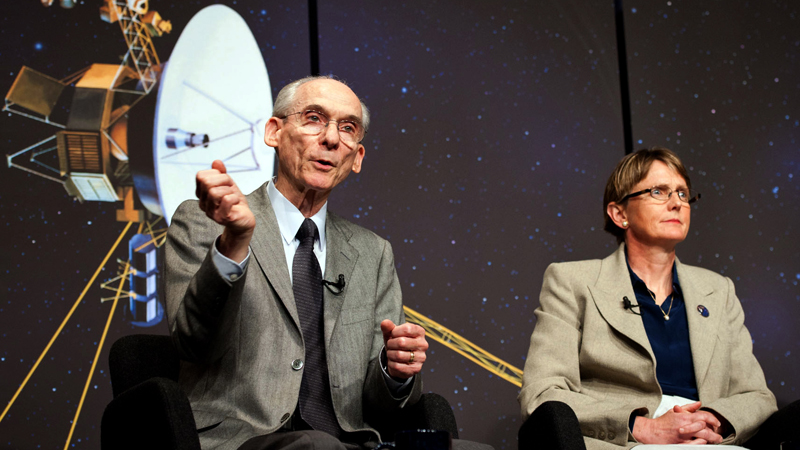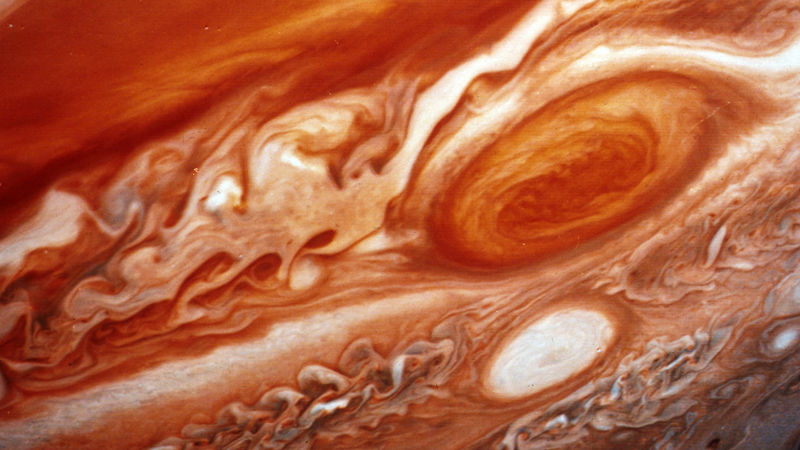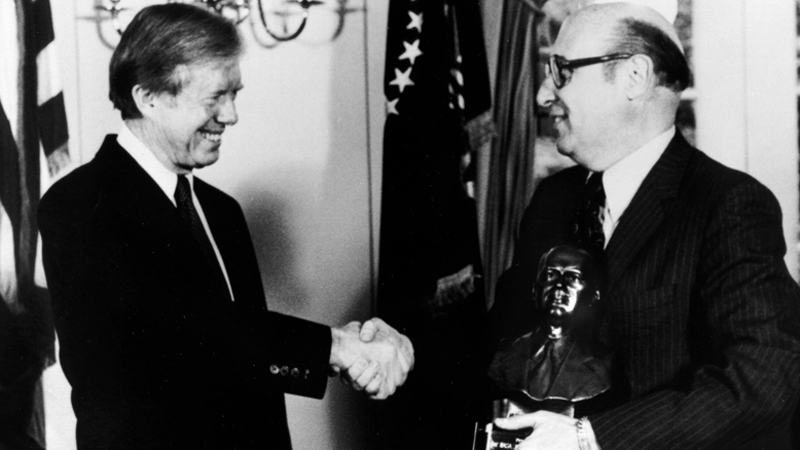That's what it's been like for the intrepid little spacecraft Voyager 1 and 2, pushing forward day after day for 40 years – the longest of any space mission. Voyager 1 has now been in interstellar space for the past four years, zooming ahead at 62,140km/h (35,000mph) – studying, among other things, how the magnetic field of our Sun interacts with the magnetic field in the interstellar space. Its sister craft is just on the edge of the interstellar space, ready to dive in.
Amazingly, the retro tech is still working, and the craft haven't collided with any asteroids along the way. Voyager "has lasted much longer than any spacecraft built today is going to last, probably," says engineer Suzanne Dodd, the Voyager project manager at Nasa’s Jet Propulsion Laboratory (JPL).
But what if we were, indeed, to build it today – how would the technology be different?
The craft itself probably wouldn’t change much, says Dodd. The thermal blanket, for instance, which protects all the sensitive electronics inside from radiation, would be very similar – just lighter, perhaps. There would still be the same nuclear power source, because solar power isn't an option – the craft are too far from the Sun. "In a lot of ways, Voyager has lasted 40 years in part due to some of the simplicity of it and the robustness of the design," says Dodd.
 Suzanne Dodd, together with Voyager chief scientist and spokesman since 1972, CalTech professor Ed Stone
Suzanne Dodd, together with Voyager chief scientist and spokesman since 1972, CalTech professor Ed Stone
Marco Scharringhausen, an engineer at the German Aerospace Centre (DLR), agrees. “I am not sure if anything would be done fundamentally different if we were to build spacecraft like Voyager 1 and 2 today,” he says. “One of the fundamentals of space engineering is conservatism.”
Phoning in
This may be true – but the Voyager programme itself was a big leap in spacecraft engineering and design, at least when compared to the Apollo technology from a few years earlier, adds Scharringhausen. Voyager’s computer and memory is based on semiconductors, while Apollo and early Nasa Mars space probes relied on ‘core rope’ memory – a form of read-only memory for computers used in the 1960s. Copper wires threaded through or around small magnetic cores, and produced the ones and zeroes of binary code.
Dodd knows Voyager as if it were her baby – now all grown up. She started working on the project when she first left university in 1984, and was involved with the Uranus and Neptune fly-bys in the late 1980s. Then she left and worked on other missions including Cassini – but came back to Voyager in 2010 to be the project manager. Today, she is responsible for overseeing the operations, reporting to Nasa on the mission's status, and keeping track of the budget and schedule.
"It's really neat - to start your career on one project, and then be able to come back to it and potentially finish off your career on the same project," she says. "Not very many people have the opportunity to do that, especially in the space business."
Not many people get to communicate with anyone – or anything – from interstellar space either. Dodd does – every week. "I come in on Monday morning and I send a command, saying: 'Hello Voyager, how are you doing?'," she says. Then she waits to hear back. It's not instantaneous – both Voyager spacecraft are very, very far from us. Voyager 1 is 139 astronomical units, or 20.6 billion km, away, and it takes 19 hours for a signal from Earth to reach it, at a very low rate of 160 bits/sec.
When the signal does come back, on Tuesday afternoon, it usually says: “Hi JPL, I'm doing fine.” It's a much slower exchange of messages than, say, sending a command to the Moon, which takes 2-3 seconds, or to Mars, which is anywhere from a 10- to a 20-minute round trip. Apart from the routine weekly check-in, once every three months Dodd sends Voyager a so-called sequence load – where code gets stored on board the spacecraft, which is then executed over the next three months.
Smaller and lighter
The on-board memory for storing sequence information is very limited – there are only about 1,500 18-bit words available between the two Computer Command Subsystem memories for storing sequence instructions. In total, Voyager has to make do with just 64kb of memory – but in a package that’s about the size of a loaf of bread. Nowadays, your smartphone has 200,000 times more memory, says Dodd – and the chip where it's stored is about the size of your pinky fingernail.
 Voyager 1 captured this photo of the Great Red Spot when it flew by Jupiter in 1979 (Credit: NASA)
Voyager 1 captured this photo of the Great Red Spot when it flew by Jupiter in 1979 (Credit: NASA)
Thanks to that, the spacecraft if built today would probably be smaller and lighter, because shrinking the memory chips would shrink the instrumentation. "Smaller is better in the sense that it’s lighter, so it allows you to go faster if you’re using the same size of rocket," says Dodd. "Or you could use a smaller rocket that would cost less money and travel at the same speed. Weight is always important to a mission because, the lighter the spacecraft, the faster you can go. Particularly if you’re trying to get to interstellar space."
Building a new Voyager 40 years on would bring dramatically improved computer memory and processing power for the instruments and sensors. The type of instruments would probably be the same, explains Dodd, such as a spectrometer and magnetometer among others, "but the technology for those instruments is now 40 years better". There are four instruments currently running on Voyager 1 and five on Voyager 2. “The Voyager 2 has an active operating plasma instrument, so, when it crosses into interstellar space, we should see immediately a change in the density of the plasma, which we couldn't do with Voyager 1,” says Dodd.
The medium the craft are travelling through has charged particles of different energy levels and thickness, and a magnetic field. The instruments measure all these different parameters – in other words, they measure the space weather. “And the weather changes quite dramatically the further you get away from the Sun,” says Dodd. “In interstellar space, Voyager 1 is moving through star dust – exploded stars, the medium that's in between the stars and planetary systems.”
Resolution of the cameras would also be much better now, says Scharringhausen, and there would be more powerful onboard computers – although those on modern spacecraft are still “way ‘weaker’ than common desktop PCs or cellphones,” he adds. That’s because onboard computers simply don't need to be that powerful when it comes to numbers – they have been designed for a very specific purpose, to run a craft or its science instruments. Our ordinary computers, he adds, are “much more prone to hang-up”.
 Former US President Jimmy Carter presents the National Space Club's Goddard Memorial Trophy to NASA Administrator Robert A. Frosch, for the Voyager mission (Credit: Alamy)
Former US President Jimmy Carter presents the National Space Club's Goddard Memorial Trophy to NASA Administrator Robert A. Frosch, for the Voyager mission (Credit: Alamy)
What would remain the same, though, is the antenna size, says Dodd. It spans 3m in diameter – and it would need to stay similar to that to be big enough to scale, given any Voyager’s distance away from the planet.
It’s no Star Wars
So what's the key to Voyager success? Dodd is clear about it: "Good engineering – and we got lucky." It's not so much lucky in terms of not hitting anything, she explains, but in the sense that the spacecraft has been robust enough and that nothing is broken. One of the reasons is that everything on board has a back-up.
"To keep the price down, they don't always build them that way now, not with that much redundancy as Voyager had," says Dodd. "That's the key reason it lasted as long, and we've always been fortunate that where we have had failures we've been able to count on the back-up side, and we haven't had any double failure yet."
One also has to look at where most failures take place, says Chris Welch, astronautics engineer at the International Space University. In terms of electronics, the Voyager spacecraft have – by modern standards – “extremely basic microcomputers, a transmitter and a receiver for communications with Earth,” he says.
But, in general, mechanisms are more difficult to make reliable than electronics – more moving parts means more possible issues, adds Welch. “Spacecraft such as Voyager have relatively few moving parts beyond some attitude control gyroscope and a movable camera platform.” And it’s exactly the camera platform that once got stuck, on Voyager 2, shortly after its passage of Saturn.
“This is a potentially fatal flaw, since the camera would not be able to properly point to the targets later on,” says Scharringhausen. “The flaw could be resolved, though, by very slowly running the mechanism to overcome resistance of some soft object that got stuck in the cogs, probably a minuscule piece of tape. Failures or flaws are not always the end of a mission.”
Both craft have also successfully travelled through the asteroid belt between the orbits of Mars and Jupiter – which, if you believe Star Wars, should be a rather bumpy ride. Nothing of the sort, laughs Dodd. "Chances of being hit by an asteroid are very remote. Space is very big and very empty," she says.
 On 24 January 1986, Voyager 2 gave us the first close-up glimpse of Uranus, here visible only as a crescent as it receded from the craft (Credit: NASA)
On 24 January 1986, Voyager 2 gave us the first close-up glimpse of Uranus, here visible only as a crescent as it receded from the craft (Credit: NASA)
She hopes that both Voyagers will continue to brave the emptiness of space for at least another decade. Their power source, a radioisotope thermal generator, may last for another 8-10 years, says Welch, before the output drops owing to the decay of the plutonium. Each Voyager draws less than 400W from the generator - much less than a typical home - and the power available is declining at the rate of 4W per year due to the decay. So to keep the craft running, in the next year or two Nasa will start turning off science instruments one at a time to make sure there is enough power to operate the transmitter.
First, heaters will be switched off – all instruments are heated as space is a pretty cold place, says Dodd. “We'll then see if that instrument still operates even though it's cold. If it continues, we'll get another year of data from it and, if it doesn't, we'll turn off the instrument also. We'll have to turn off an instrument about once a year over a course of about five years,” she adds.
One day, though, Voyager may not respond to Dodd’s weekly greeting. “On a personal level, I would be very worried and very scared that we have lost the spacecraft. On a technical level, we would try to figure out why we were not hearing from it – we would send some commands to try and retrieve it.
“If we did it over a few weeks and still didn't hear back, I think we would need to declare that the mission was over. And that would be an extremely sad day. It's sort of like realising that your ageing parent has passed away.”
This article appears in the print July/August issue of PE